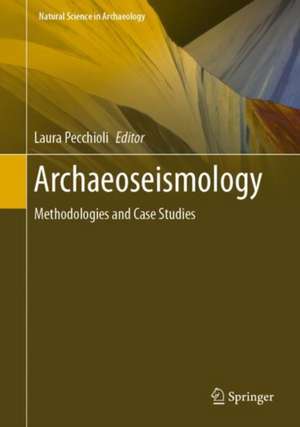Archaeoseismology: Methodologies and Case Studies: Natural Science in Archaeology
Editat de Laura Pecchiolien Limba Engleză Hardback – 13 aug 2023
Din seria Natural Science in Archaeology
- 24%
 Preț: 876.52 lei
Preț: 876.52 lei -
 Preț: 441.37 lei
Preț: 441.37 lei - 20%
 Preț: 568.24 lei
Preț: 568.24 lei - 15%
 Preț: 654.30 lei
Preț: 654.30 lei - 18%
 Preț: 957.62 lei
Preț: 957.62 lei - 18%
 Preț: 2101.51 lei
Preț: 2101.51 lei - 18%
 Preț: 1383.49 lei
Preț: 1383.49 lei - 18%
 Preț: 1233.06 lei
Preț: 1233.06 lei - 18%
 Preț: 1836.63 lei
Preț: 1836.63 lei - 18%
 Preț: 1108.99 lei
Preț: 1108.99 lei - 24%
 Preț: 685.62 lei
Preț: 685.62 lei - 18%
 Preț: 960.89 lei
Preț: 960.89 lei - 15%
 Preț: 650.86 lei
Preț: 650.86 lei - 24%
 Preț: 745.38 lei
Preț: 745.38 lei - 18%
 Preț: 1014.76 lei
Preț: 1014.76 lei - 15%
 Preț: 651.34 lei
Preț: 651.34 lei - 24%
 Preț: 821.94 lei
Preț: 821.94 lei - 18%
 Preț: 1119.71 lei
Preț: 1119.71 lei
Preț: 787.29 lei
Preț vechi: 960.11 lei
-18% Nou
Puncte Express: 1181
Preț estimativ în valută:
150.64€ • 158.13$ • 125.04£
150.64€ • 158.13$ • 125.04£
Carte tipărită la comandă
Livrare economică 10-24 aprilie
Preluare comenzi: 021 569.72.76
Specificații
ISBN-13: 9783031283024
ISBN-10: 3031283023
Ilustrații: XXI, 192 p. 110 illus., 88 illus. in color.
Dimensiuni: 178 x 254 mm
Greutate: 0.59 kg
Ediția:1st ed. 2023
Editura: Springer International Publishing
Colecția Springer
Seria Natural Science in Archaeology
Locul publicării:Cham, Switzerland
ISBN-10: 3031283023
Ilustrații: XXI, 192 p. 110 illus., 88 illus. in color.
Dimensiuni: 178 x 254 mm
Greutate: 0.59 kg
Ediția:1st ed. 2023
Editura: Springer International Publishing
Colecția Springer
Seria Natural Science in Archaeology
Locul publicării:Cham, Switzerland
Cuprins
Part I. Stratigraphic Analysis and Seismic Evidence.- Chapter 1. Stone Materials, Processes and Mortars in Archaeosismology Studies. The Case of Mugello (Tuscany-Italy).- Chapter 2. Reading the Earthquake of 1542 in the Walls of the Church of Sant'Agata del Mugello: The Need for a Multidisciplinary Approach.- Chapter 3. The Partial Collapse of the Basilica of Maxentius in Late Antiquity: An Evaluation of Possible Destruction Causes.- Part II. Identification and Classification Methods.- Chapter 4. The Archaeology of Post-Earthquake Repairs: New Insights into Building Processes in Roman Pompeii.- Chapter 5. Application of Geological Techniques to Identify Earthquakes Affecting Archaeological Sites: The Example of the 2011 Lorca Earthquake (SE Spain).- Part III. Anti-Seismic Measures in Ancient Building Construction and in the Vernacular Tradition.- Chapter 6. Anti-Seismic Measures in the Building Tradition.- Chapter 7. The Temple B in Pietrabbondante (Isernia, Italy) as a Case Study of Seismic Shield Properties of Roman-Italic Temple Foundations and Podiums.- Chapter 8. A Predictive Nonlinear 2D Mechanical Model for FEM Analysis of Trait de Jupiter Wooden Joints.- Part IV. Historical Seismicity.- Chapter 9. Roman Corinth and Wider Area (Greece): An Area Characterized by Debates on Ancient Earthquakes and by Earthquakes with Observable Signs.- Chapter 10. Research on Historical Seismicity in Vienne (France): From Archaeoseismological Observations to the Archaeological Identification of ‘Viennese’ Earthquakes in Antiquity and the Middle Ages.- Chapter 11. Assessment and Reduction of Seismic Damage to Buildings of Historical Interest.
Notă biografică
After graduating from the University of Florence in Architecture, Laura Pecchioli has specialized in restoring monuments and technologies for conserving archaeological sites. In addition, she has participated in various interdisciplinary research projects in archaeological building research and archaeological excavations with international interdisciplinary teams (Italy and Jordan).
After completing her European Ph.D. in Technology and Management in Cultural Heritage, Pecchioli has been a lecturer and researcher in heritage conservation-restoration (Florence, Berlin, and Rome). She has also been an external lecturer in Archaeoseismology at Humboldt University and, recently, at TU Wien.
Pecchioli has co-edited different scientific journals and is a member of several European project committees (European Science Foundation). Her current research interests include archaeoseismology, post-disaster recovery, urban and infrastructure resilience, climate change, armed conflicts, damage assessment and risk management.
Pecchioli has co-edited different scientific journals and is a member of several European project committees (European Science Foundation). Her current research interests include archaeoseismology, post-disaster recovery, urban and infrastructure resilience, climate change, armed conflicts, damage assessment and risk management.
Textul de pe ultima copertă
Archaeoseismic research provides data and information on past earthquakes but is limited by the lack of ongoing discussions about methodology. This volume is an interdisciplinary approach including archaeologists, geologists, geophysicists, seismologists, engineers, and architects from different countries to present a comprehensive recording and interpretation of ancient natural disasters on some case studies. The publication is an introduction to various aspects of the field of archaeoseismology for the knowledge of past seismicity, the reconstruction of the chronological history of a place, the interpretation and identification of seismic effects using different methods, etc. The collection provides an overview of research into archaeoseismology, making new contributions through innovative ideas on various topics. The publication can be an illustrative introduction to better understand the complexity of interpreting seismic effects on ancient and modern masonries, particularly for students with an open mind.
Caracteristici
Includes methodical collections and case-studies on archaeoseismology Contributes a better understanding on regional seismic hazard assessment Introduces an open-minded and interdisciplinary approach to archaeoseismology
